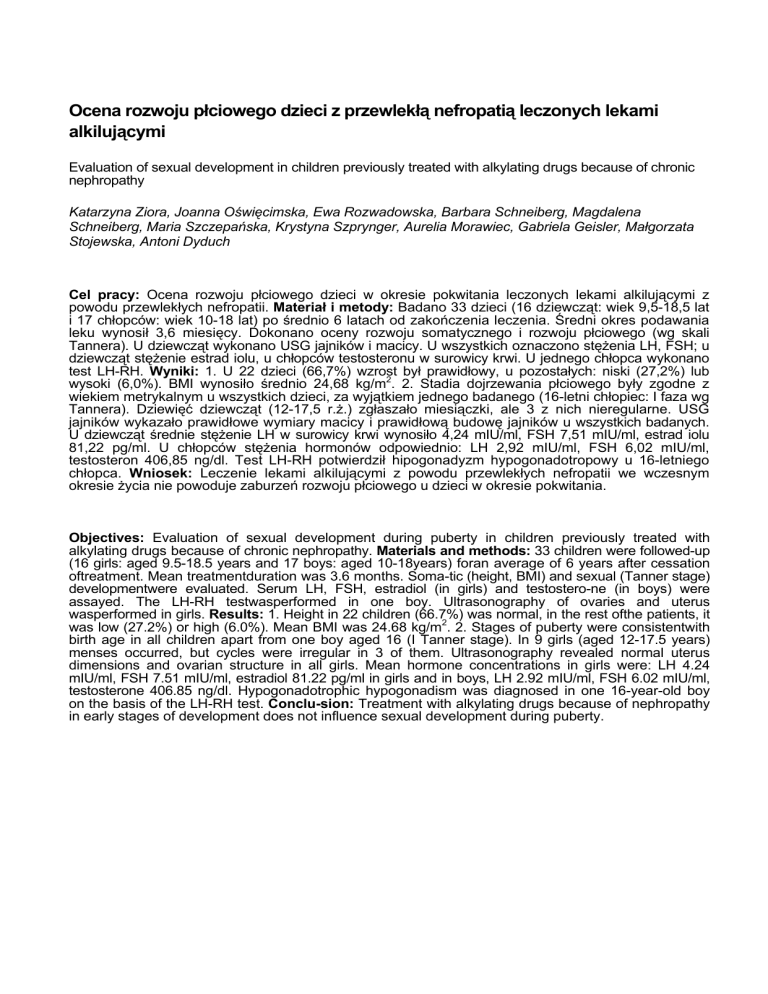
Ocena rozwoju płciowego dzieci z przewlekłą nefropatią leczonych lekami
alkilującymi
Evaluation of sexual development in children previously treated with alkylating drugs because of chronic
nephropathy
Katarzyna Ziora, Joanna Oświęcimska, Ewa Rozwadowska, Barbara Schneiberg, Magdalena
Schneiberg, Maria Szczepańska, Krystyna Szprynger, Aurelia Morawiec, Gabriela Geisler, Małgorzata
Stojewska, Antoni Dyduch
Cel pracy: Ocena rozwoju płciowego dzieci w okresie pokwitania leczonych lekami alkilującymi z
powodu przewlekłych nefropatii. Materiał i metody: Badano 33 dzieci (16 dziewcząt: wiek 9,5-18,5 lat
i 17 chłopców: wiek 10-18 lat) po średnio 6 latach od zakończenia leczenia. Średni okres podawania
leku wynosił 3,6 miesięcy. Dokonano oceny rozwoju somatycznego i rozwoju płciowego (wg skali
Tannera). U dziewcząt wykonano USG jajników i macicy. U wszystkich oznaczono stężenia LH, FSH; u
dziewcząt stężenie estrad iolu, u chłopców testosteronu w surowicy krwi. U jednego chłopca wykonano
test LH-RH. Wyniki: 1. U 22 dzieci (66,7%) wzrost był prawidłowy, u pozostałych: niski (27,2%) lub
wysoki (6,0%). BMI wynosiło średnio 24,68 kg/m2. 2. Stadia dojrzewania płciowego były zgodne z
wiekiem metrykalnym u wszystkich dzieci, za wyjątkiem jednego badanego (16-letni chłopiec: I faza wg
Tannera). Dziewięć dziewcząt (12-17,5 r.ż.) zgłaszało miesiączki, ale 3 z nich nieregularne. USG
jajników wykazało prawidłowe wymiary macicy i prawidłową budowę jajników u wszystkich badanych.
U dziewcząt średnie stężenie LH w surowicy krwi wynosiło 4,24 mIU/ml, FSH 7,51 mIU/ml, estrad iolu
81,22 pg/ml. U chłopców stężenia hormonów odpowiednio: LH 2,92 mIU/ml, FSH 6,02 mIU/ml,
testosteron 406,85 ng/dl. Test LH-RH potwierdził hipogonadyzm hypogonadotropowy u 16-letniego
chłopca. Wniosek: Leczenie lekami alkilującymi z powodu przewlekłych nefropatii we wczesnym
okresie życia nie powoduje zaburzeń rozwoju płciowego u dzieci w okresie pokwitania.
Objectives: Evaluation of sexual development during puberty in children previously treated with
alkylating drugs because of chronic nephropathy. Materials and methods: 33 children were followed-up
(16 girls: aged 9.5-18.5 years and 17 boys: aged 10-18years) foran average of 6 years after cessation
oftreatment. Mean treatmentduration was 3.6 months. Soma-tic (height, BMI) and sexual (Tanner stage)
developmentwere evaluated. Serum LH, FSH, estradiol (in girls) and testostero-ne (in boys) were
assayed. The LH-RH testwasperformed in one boy. Ultrasonography of ovaries and uterus
wasperformed in girls. Results: 1. Height in 22 children (66.7%) was normal, in the rest ofthe patients, it
was low (27.2%) or high (6.0%). Mean BMI was 24.68 kg/m2. 2. Stages of puberty were consistentwith
birth age in all children apart from one boy aged 16 (I Tanner stage). In 9 girls (aged 12-17.5 years)
menses occurred, but cycles were irregular in 3 of them. Ultrasonography revealed normal uterus
dimensions and ovarian structure in all girls. Mean hormone concentrations in girls were: LH 4.24
mIU/ml, FSH 7.51 mIU/ml, estradiol 81.22 pg/ml in girls and in boys, LH 2.92 mIU/ml, FSH 6.02 mIU/ml,
testosterone 406.85 ng/dl. Hypogonadotrophic hypogonadism was diagnosed in one 16-year-old boy
on the basis of the LH-RH test. Conclu-sion: Treatment with alkylating drugs because of nephropathy
in early stages of development does not influence sexual development during puberty.
